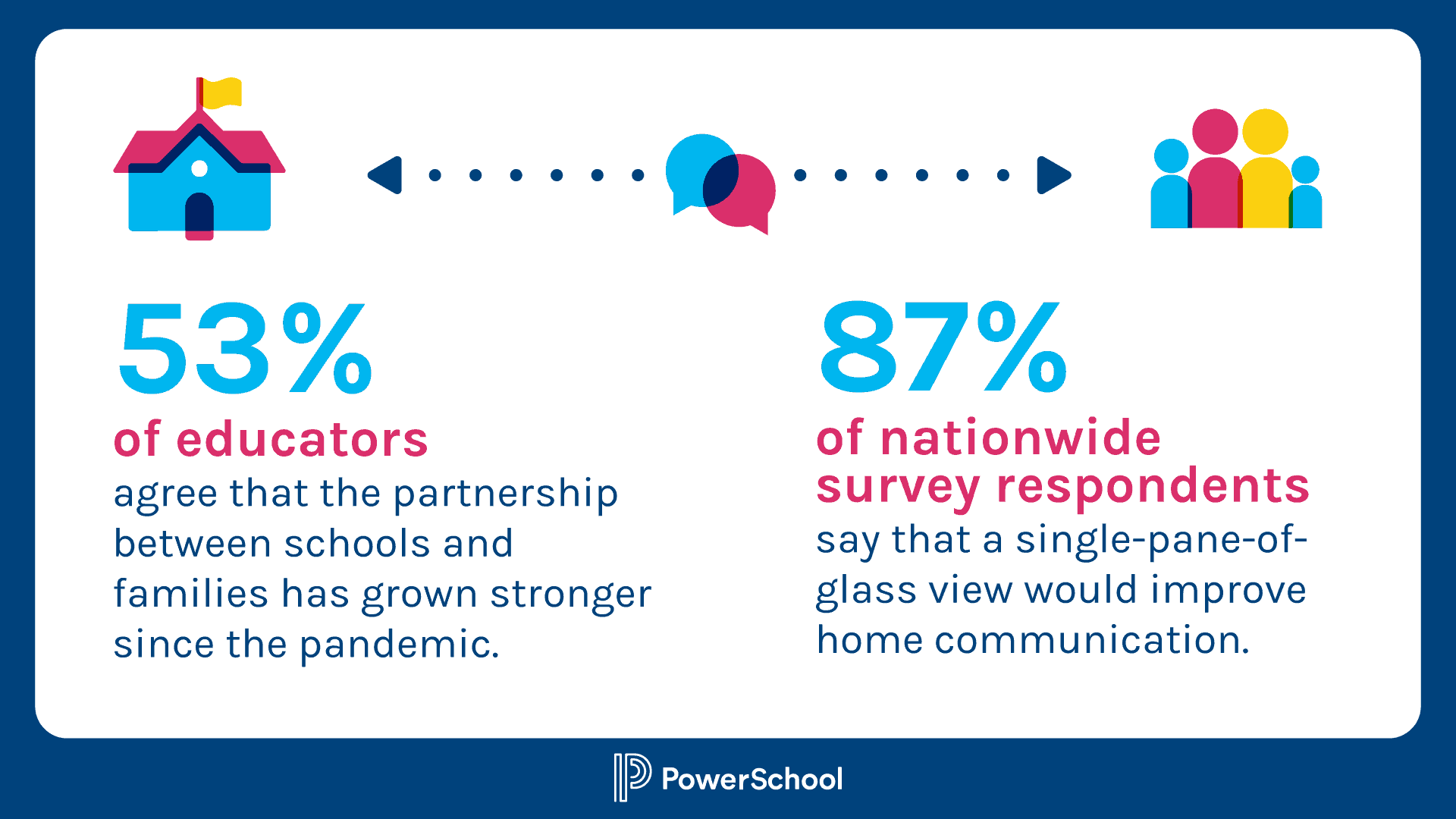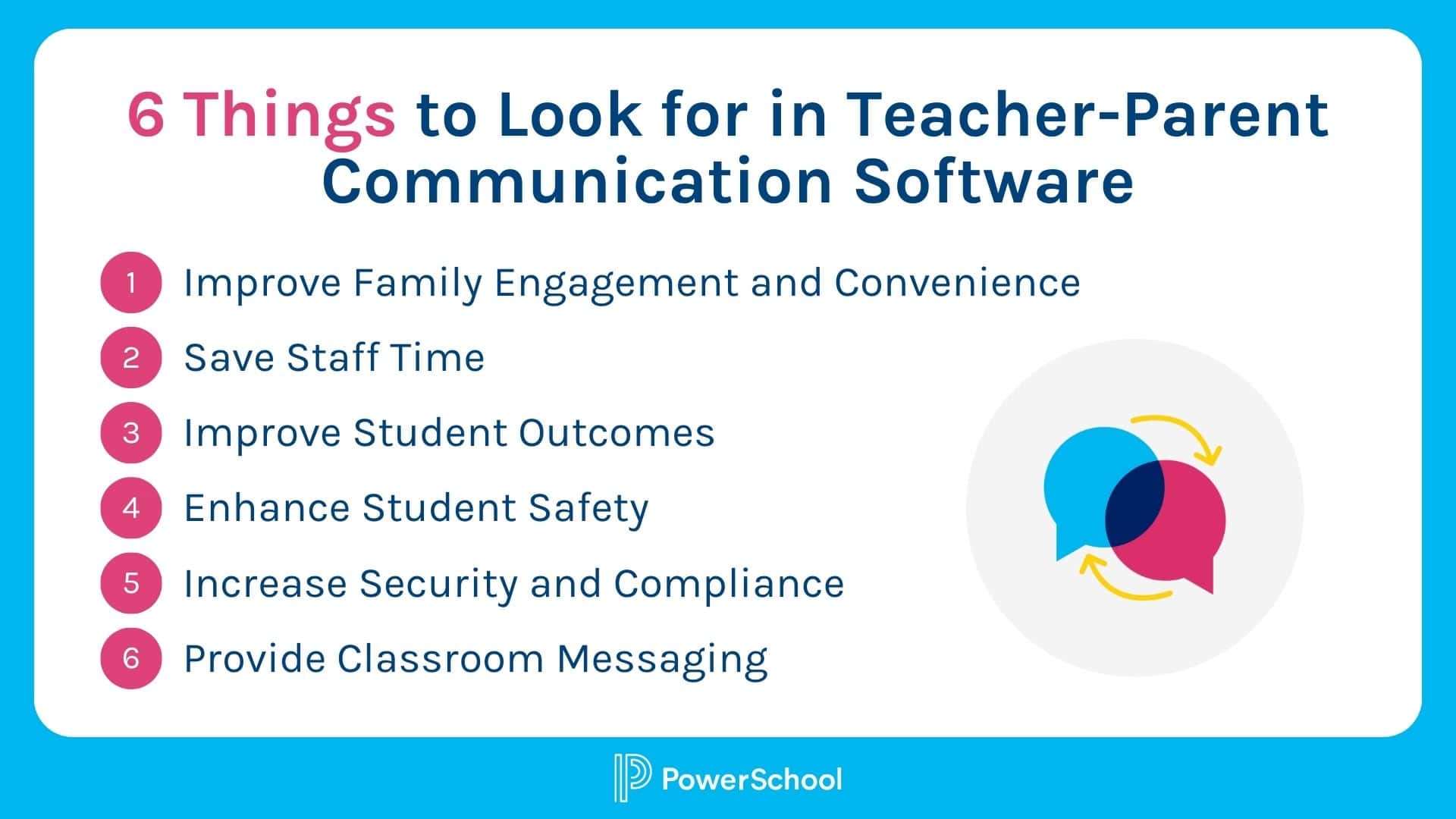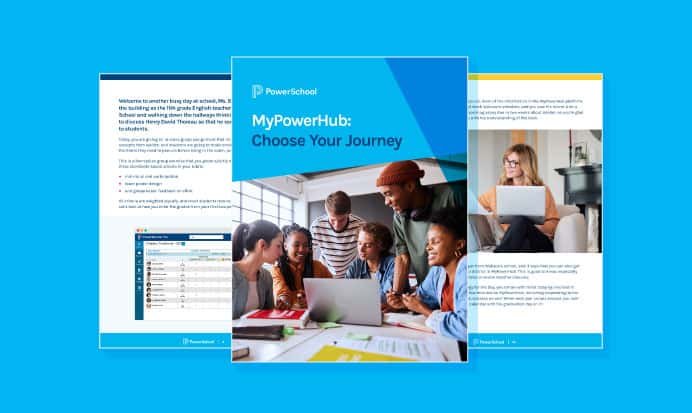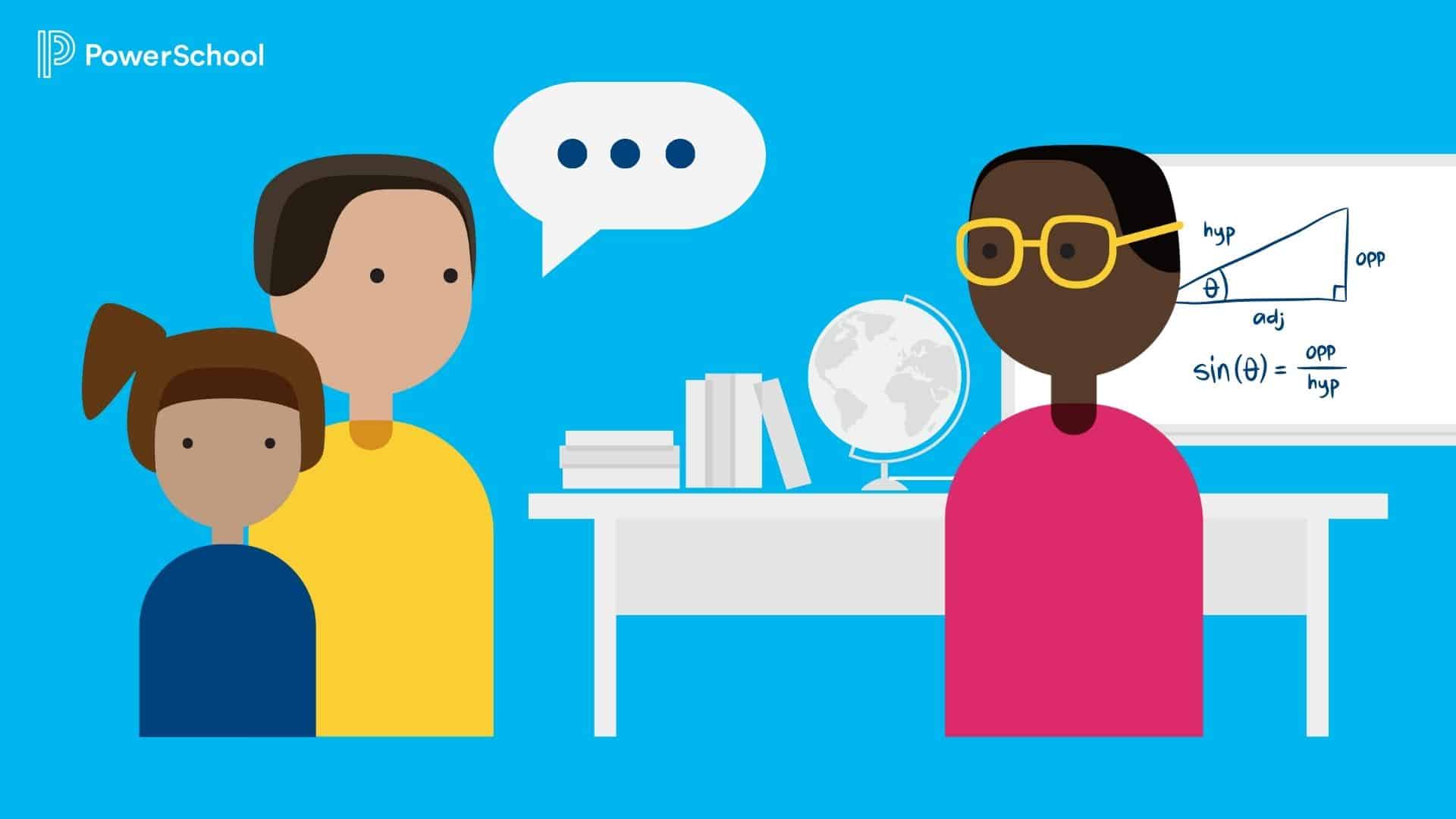
Regular communication between teachers and families is vital to a student’s success. When communication is effective, it builds engagement that leads to higher student grades, a greater likelihood of graduation, and more success in postsecondary education. Plus, when schools nurture strong relationships with families, absenteeism falls by as much as 40%.
While school-home communication is one aspect of collaboration, there is also an aspect of school communications that cannot be overlooked: the district-to-community connection. District-level communications roles are key in a school ecosystem, and they set the tone for the ways in which all communication takes place—no matter whether it’s between a district and external stakeholders or whether they are training school staff about best practices for connecting with families.
What is Teacher & Parent Communication?
Teacher and parent communication is ongoing, two-way engagement. In an effective relationship, teachers, parents, guardians, and family members exchange information and updates to support the student’s education and well-being. Parent-teacher communication fosters a collaborative partnership that enhances the student’s learning experience and overall development.
Teachers tell parents and guardians what’s happening in class, like assignments, grades, assessment results, behavior, and social and emotional learning information. Teachers also share students’ strengths, from their perspective, where they may need some help, and overall information relating to the entire class and school.
Parents share how their student is doing at home, any concerns they may have, and ask questions about their student and how they can help the student succeed.
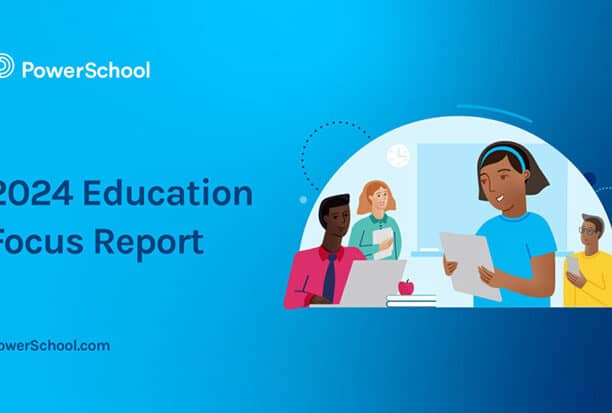
2024 Education Focus Report
Learn what educators and families are saying about communication today.
Get the ReportWhy Is It Important for Teachers and Parents to Communicate?
When teachers and parents effectively communicate with each other, they can collaborate and share ideas from different perspectives in the best interest of the student’s development and success. Collaboration and partnership combine classroom insights with home observations and provide a holistic view of the whole child, opening up possibilities for personalized education, tailored support, and early interventions.
Parent-teacher communication instigates parent engagement in their student’s education and quality of life. Research shows that students succeed when families are involved in the education process.
- Students earn higher grades and do better on tests when parents are involved
- Meaningful family engagement has a positive impact not only on academic achievement but also on mental health and behavioral health
- Teachers report significant changes in their classrooms around student motivation, behavior, and attendance when families help ensure students attend class, encourage and support learning at home, and regularly communicate with school staff

Learn how schools can achieve better student outcomes by engaging families and leveraging them as partners in their student’s success.
Download the Guide to Family-School PartnershipsBenefits of Teacher and Parent Communication
Great things happen when families engage in their student’s education. Research shows that when parents are involved, students have higher success in graduating from high school and attending post-secondary education. Plus, when schools nurture family connections and build strong school-family relationships, you can reduce absenteeism by 40%.
Student Benefits
When teachers collaborate with families (including parents and guardians), students benefit with improved academic performance and development. Teachers and parents working together help identify and address educational challenges, learning difficulties, and behavioral issues early on, leading to better student outcomes. A strong connection between school and home can also identify areas of student success and mastery, informing personalized education efforts to help advance the student to meet new challenges.
Parent, Guardian, and Caregiver Benefits
When parents actively engage in their students’ education, students perform better academically, have higher self-esteem, and develop a more positive attitude toward school. In a supportive and caring home environment with engaged parents, students are “less likely to become involved in substance abuse, violence, and other problem behaviors,” according to an American Psychological Association article.
Parents also benefit from being partners in and contributors to their student’s education. In the shared responsibility of educating the student, parents are informed about what their student is learning and experiencing in school. The partnership between parents and schools fosters trust between these contributors, and parents often gain more confidence in the school’s ability to provide a quality education.
Educator Benefits
By communicating regularly with parents and guardians, teachers gain better insight into the whole child, including the student’s behavior, home life factors, and support system. This additional perspective provides a more comprehensive understanding of the student, leading to more effective teaching.
7 Ways Teachers Can Improve Communications with Parents
Effective communication between teachers and parents is crucial for a student’s success and well-being. Here are seven ways teachers can improve their communication with parents:
1. Regular Updates:
Staying in touch regularly is critical to keeping parents informed and engaged. Updates can include classroom activities, assignments, events, and student performance—through applications, online parent portals, text, emails, chat functionality, or newsletters.
2. Open House and Parent-Teacher Conferences:
Open houses and parent-teacher conferences allow parents and guardians to meet their student’s teachers and discuss progress, challenges, or growth opportunities. This enables face-to-face interaction and two-way communication.
3. Two-Way Communication:
Teachers should facilitate opportunities and encourage parents to share their insights and concerns. Create a welcoming environment where parents feel comfortable discussing their child’s academic and behavioral progress.
4. Digital Tools:
Technology is an efficient, effective way to enhance communication and promote continuing engagement. Online platforms, mobile apps, or websites can be used to share updates, assignments, and resources with parents.
5. Positive Feedback:
Share positive feedback about a student’s accomplishments, behavior, or improvements. This fosters a positive relationship and reinforces the idea that teacher-parent collaboration is focused on the child’s growth.
6. Personalized Communication:
Each student is unique, and teachers should tailor communication to address each student’s needs and strengths. Personalized communication shows that you value each child’s development.
7. Focus on Equity and Accessibility:
Teachers should ensure communication is clear, easy to understand, and translated into a family’s first language when possible. Communication methods should be accessible to all parents, including those with disabilities.

Tips to Improve Communication with All Families
Download the InfographicWhat to Consider when Selecting a Classroom Communications Platform
Effective communication between schools, educators, and parents is essential to a child’s academic success. The challenge is that there’s no shortage of classroom communications solutions available these days, and it can be difficult for schools to choose the right platform that meets their needs.
By understanding the following factors, schools can choose a platform that meets their unique needs and fosters a collaborative environment for students, parents, and educators.
SOURCE: 2024 Education Focus Report
Getting Parents Involved
Parents play a critical role in their child’s education, and by keeping them informed and engaged, schools can create a supportive environment that promotes academic success. Increased parent engagement can be achieved through regular updates, accessible communication channels, and easy-to-use tools that allow parents to stay connected and informed about their child’s academic progress.
By prioritizing parent engagement, schools can foster a sense of collaboration and partnership that benefits students, parents, and educators and breaks down the barriers to effective communications.
Protecting Data
As the use of education technology accelerates, it’s essential to ensure that student data is kept secure and confidential. With many apps for educators to choose from, it can be difficult to understand the risks of using those platforms. By collecting data they shouldn’t for these singular platforms, educators could be putting themselves, their school, their district, students, and parents at risk.
K-12 district leadership has a duty to ensure personally identifiable information (PII) is protected. Schools must choose a platform with strict security protocols to safeguard student, parent, and staff data, including data encryption and regular third-party security audits.
Ultimately, it is best to limit the number of vendors that have access to this type of data and work with platform providers you can trust. By prioritizing data security, schools can create a safer and more secure environment for students and parents, and foster trust and confidence in the platform.
Ensuring Consistency
With a multitude of apps and platforms available, it can be challenging for parents to keep track of everything. A streamlined and user-friendly platform can make it easy for parents to stay connected with their child’s education.
By ensuring a consistent experience across all devices and platforms, parents can feel more confident and comfortable using the app and staying engaged with their child’s education.
The Right Platform for Specific Needs
In today’s digital age, many classroom communication tools are available to facilitate the typical types of classroom communication. Whether schools want to send parents updates on student progress, share photos of classroom activities, or send invitations to join after-school groups, there are plenty of mobile apps, websites, and other services that claim to help with that.
Finding the right classroom communications platform—not just any platform, and not an assortment of random solutions – should be the top goal. Schools can choose a platform that meets their unique needs by considering factors such as parent engagement, data security, and consistency in communication apps. And when the right classroom communications platform is in place, schools can create a learning environment where all students can reach their full potential.
6 Things to Look for in Teacher-Parent Communication Software
When selecting communication and notification software to facilitate interactions between teachers and parents, it’s important to consider features that enhance transparency, efficiency, and engagement.
PowerSchool SchoolMessenger is a trusted platform for delivering student support with increased parent and community engagement. SchoolMessenger combines mass communication, emergency messaging, school-specific notifications, digital forms, and attendance management within one easy-to-use platform. This communication system increases student support while saving time and providing more immediate, complete engagement throughout a school community.
Here are six benefits of SchoolMessenger’s teacher and parent communication software:
1) Improve Family Engagement and Convenience:
The platform enables schools and teachers to reach every parent or guardian across voice, text, email, and social media messaging. SchoolMessenger also provides automatic translations for over 100 languages to help break down communication barriers, providing a convenient way for every family, regardless of language, to stay actively engaged.
SchoolMessenger provides schools and districts with trusted mass communication and emergency messaging capabilities. This best-in class tool for parent, community, and classroom engagement and communication capabilities is ready for any crisis schools face.
2) Save Staff Time:
Software can help ease the burden on staff by eliminating manual tasks like listening to absence voicemails, combing through various attendance notes and parent emails, or manually calling parents to determine if their child is legitimately absent.
3) Improve Student Outcomes:
SchoolMessenger lets educators send timely and consistent school notifications about upcoming events, assignments, or even issues like school closures, that keep them informed and engaged in their student’s education.
4) Enhance Student Safety:
Educators can hone in on valid unexcused absences and ensure families and schools have immediate awareness of discrepancies in student attendance to allow for prompt action.
5) Increase Security and Compliance:
Digital safety is enhanced with a secure system that works to protect students’ and staff’s personal information and is compliant with the Family Educational Rights and Privacy Act (FERPA).
6) Provide Classroom Messaging:
SchoolMessenger Chat is a two-way messaging solution to improve parent communication and student success. This feature lets teachers and administrators reach every parent and achieve communications equity, improve teacher-parent relationships so parents are engaged and involved, and enhance performance by helping parents stay connected to their student’s education.
PowerSchool School Messenger and MyPowerHub work together for a more complete communications system that expands family access by offering a single access point for student work, progress, alerts, and school-home communication. In our nationwide survey for the 2024 Education Focus Report, we learned that 87% of educators say a “single pane of glass” solution that consolidates information would help improve communication between school and home.
How PowerSchool Helps Teacher and Parent Communication
We understand that a quality school communications strategy requires effort and consistency at the district level. Oftentimes, this work is guided by a communications director who knows the best ways to engage families around student learning and success.
When a communications leader can effectively share district-wide communication goals and processes with school staff, this trickles down to the ways in which teachers connect with families and students. With a cohesive strategy, and the right tools, teachers can reliably enact best practices in communication to foster student achievement.
PowerSchool SchoolMessenger is our tested and proven platform that provides over 63,000 schools in North America with cybersecure tools to reach every family across voice, text, email, and social media messaging–with automatic translations for over 100 languages. SchoolMessenger supports emergency alerts, classroom messaging, paperless permission forms, waivers, and more—and it integrates with over 130 established systems, like PowerSchool SIS and MyPowerHub, in a simple interface.
MyPowerHub: Communication and Engagement for Every Journey
Discover a single access point for better school-home communication by choosing a character and walking through their MyPowerHub user experience.
Get the eBook
